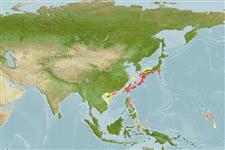>
Eupercaria/misc (Various families in series Eupercaria) >
Labridae (Wrasses) > Cheilininae
Etymology: Cirrhilabrus: Latin, cirrus = curl fringe + Greek, labros = furious (Ref. 45335).
More on authors: Randall & Masuda.
Environment: milieu / climate zone / depth range / distribution range
Ökologie
seewasser riff-verbunden; tiefenbereich 30 - 55 m (Ref. 48636). Subtropical
Northwest Pacific: Okinawa and the Ogasawara Islands. Also recorded from Taiwan (Ref. 48452); Bali and Sangihe Islands in Indonesia (Ref. 47567).
Size / Gewicht / Alter
Maturity: Lm ? range ? - ? cm
Max length : 8.5 cm SL Männchen/unbestimmt; (Ref. 10692); 4.5 cm SL (female)
Rückenflossenstacheln (insgesamt): 11; Rückenflossenweichstrahlen (insgesamt): 9; Afterflossenstacheln 3; Afterflossenweichstrahlen: 9. In females, upper and middle part of body with several orange-red longitudinal stripes from snout to caudal peduncle; whitish on abdomen, thorax, and lower part of head (Ref. 48452). Young specimens with a black spot on upper part of caudal and 3 dark red stripes on upper part of body (Ref. 48452). Caudal fin rounded in female and young fish; strongly lunate in male (Ref. 48452).
Collected at depths ranging from 32 to 45 m on dead coral and rubble substratum.
Life cycle and mating behavior
Geschlechtsreife | Fortpflanzung | Ablaichen | Eier | Fecundity | Larven
Distinct pairing during breeding (Ref. 205).
Randall, J.E., 1992. A review of the labrid fishes of the genus Cirrhilabrus from Japan, Taiwan and the Mariana Islands, with descriptions of two new species. Micronesica 25(1):99-121. (Ref. 5278)
IUCN Rote Liste Status (Ref. 130435)
Bedrohung für Menschen
Harmless
Nutzung durch Menschen
Mehr Information
ReferenzenAquakulturAquakultur ProfilZuchtlinienGenetikElectrophoresesVererbbarkeitKrankheitenVerarbeitungNutrientsMass conversion
PartnerBilderStamps, Coins Misc.LauteCiguateraGeschwindigkeitSchwimmstilKiemenoberflächeOtolithsGehirngrößeSehfähigkeit
Tools
Zusatzinformationen
Download XML
Internet Quellen
Estimates based on models
Preferred temperature (Ref.
123201): 19.5 - 25.5, mean 24 °C (based on 10 cells).
Phylogenetic diversity index (Ref.
82804): PD
50 = 0.5000 [Uniqueness, from 0.5 = low to 2.0 = high].
Bayesian length-weight: a=0.01585 (0.00707 - 0.03555), b=2.95 (2.76 - 3.14), in cm total length, based on LWR estimates for this (Sub)family-body shape (Ref.
93245).
Trophic level (Ref.
69278): 3.4 ±0.4 se; based on size and trophs of closest relatives
Widerstandsfähigkeit (Ref.
120179): hoch, Verdopplung der Population dauert weniger als 15 Monate. (Preliminary K or Fecundity.).
Fishing Vulnerability (Ref.
59153): Low vulnerability (10 of 100).
